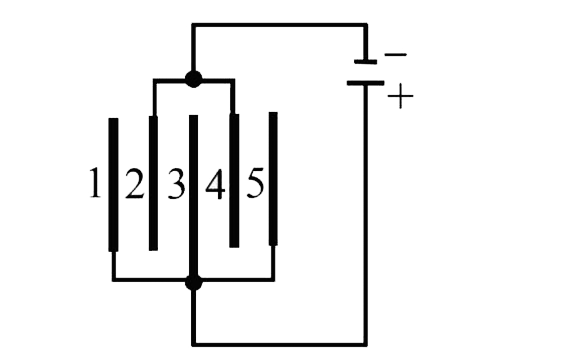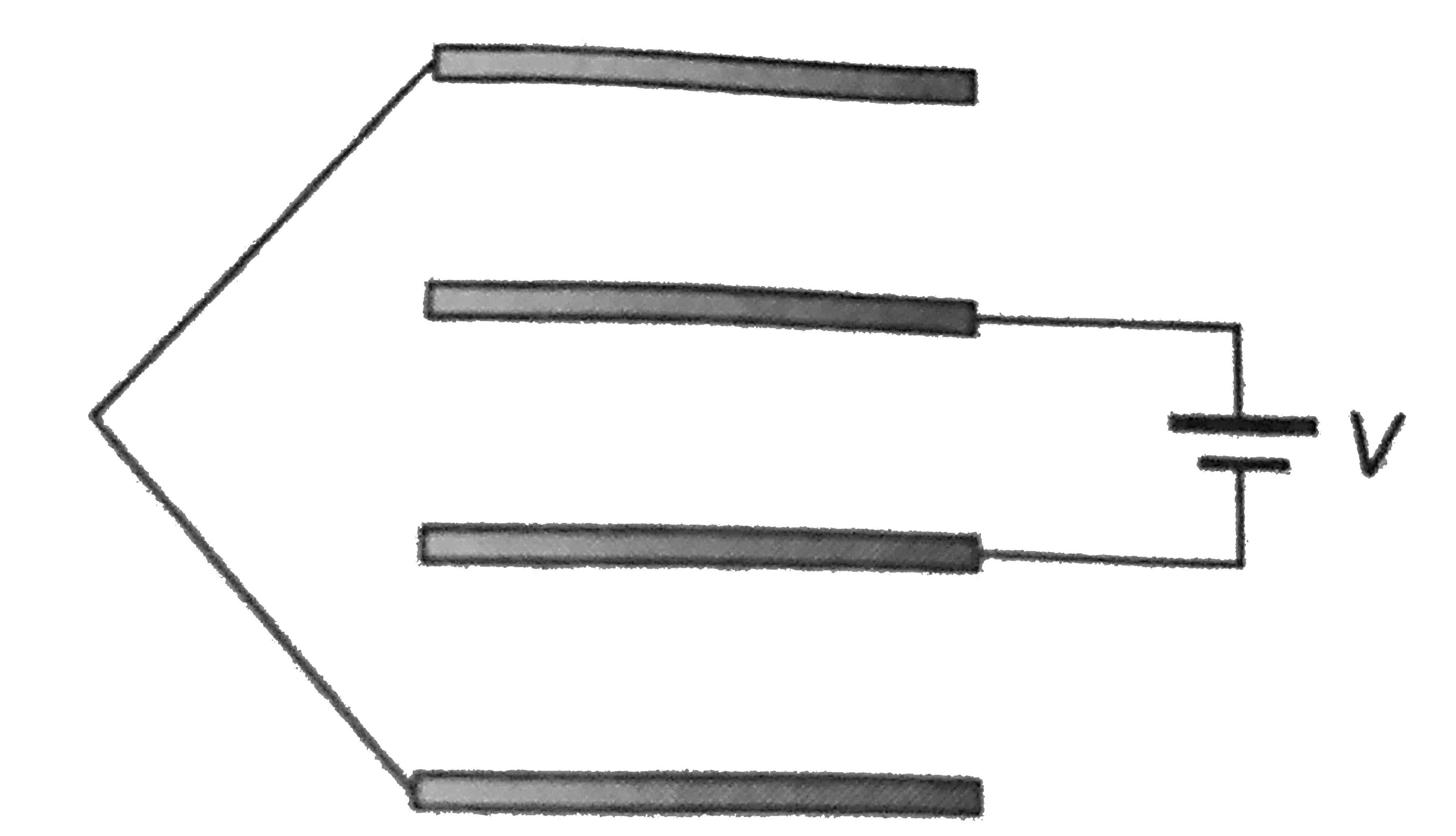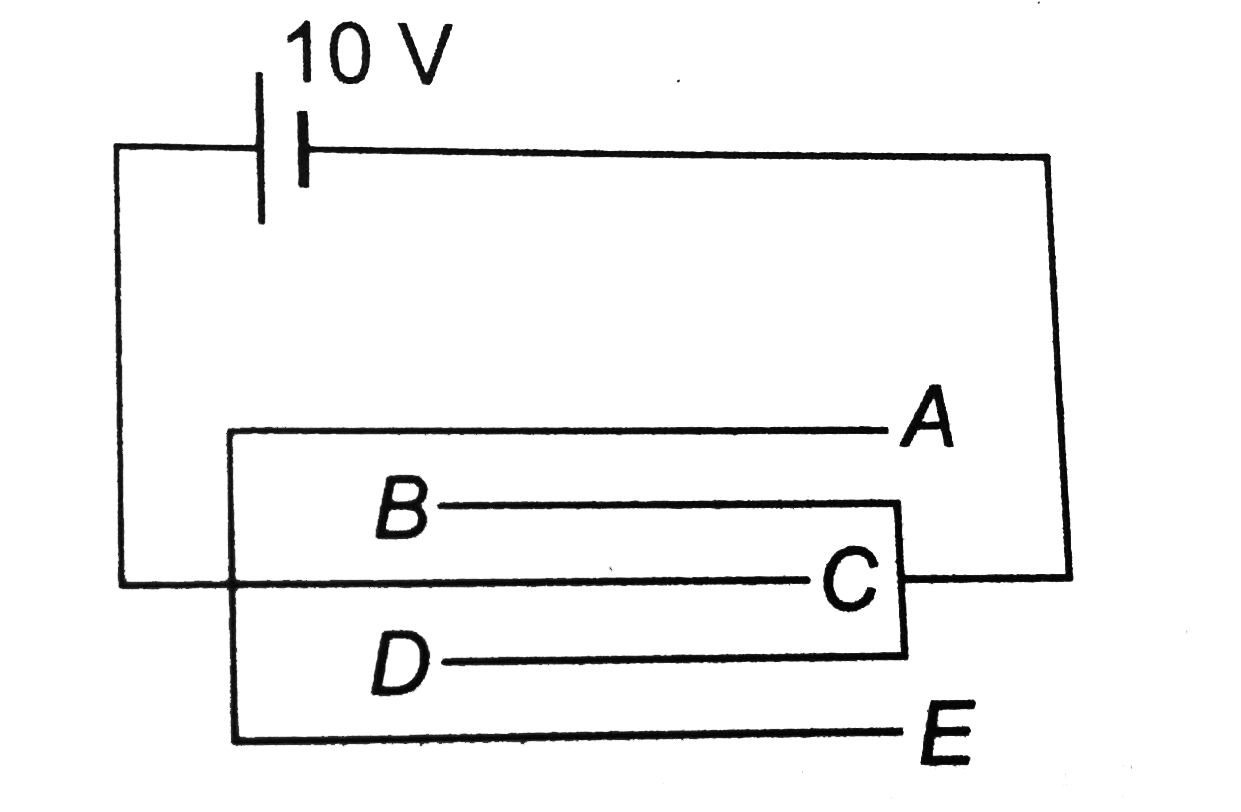Five identical capacitor paltes, each of area A, are arranged such that adjacent plates are at a distance d apart, the plates are connected to a source of emf V as shown in the figure

The charge on plate 1 is ………..and on plate 4 is.............
∈0Ad,−2∈0Ad
∈0AVd,−2∈0AVd
−∈0AVd,−3∈0AVd
∈0AVd,−4∈0AVd
The correct Answer is:B

by equivalent circuit diagram Charge on first plate Q = CV
Q=∈0AVd
Charge on fourth plate Q = C(-V) Q=−∈0AVd
As plate 4 is repeated twice, hence charge on 4 will be Q''=2Q'
Q=−2∈0AVd
Hence the correct answer will be (B).
Topper's Solved these Questions
- CAPACITANCEBOOK - RESONANCECHAPTER - CAPACITANCEEXERCISE - Miscellaneous Solved Example
3 Videos
- CAPACITANCEBOOK - RESONANCECHAPTER - CAPACITANCEEXERCISE - Exercise - 1
79 Videos
- ATOMIC PHYSICSBOOK - RESONANCECHAPTER - ATOMIC PHYSICSEXERCISE - Advanved level problems
17 Videos
- COMMUNICATION SYSTEMSBOOK - RESONANCECHAPTER - COMMUNICATION SYSTEMSEXERCISE - Exercise 3
13 Videos
Similar Questions
(a) Find the potential difference between the plates of a parallel plate capacitor of capacitance 5μF if a charge +800μC is placed on one plate and-200μC on another plate.
(b) The charege given to plate are as shown. The capacitance between the adjacent plates is C. find the charge on outer surface of plate 3, and potential difference between plate 1 and 2.
(c) If A is area of each plate and d is separation between adjacent plates, find the charge supplied by battery.
(d) Five idential capacitor plates each of area A are arranged such that adjacent plates are at a distance d apart. the plates are connected to a source of emf V as shown. what is the magnitude and nature of charge on plates 1 and 3 respectively?



View SolutionFive identical capacitor plates, each of surface area 'A', are arranged such that adjacent plates are at distance 'd' apart. The alternate plates are joined together as shown in Fig. The capacitance of the arrangement is __________ .

View Solution
Knowledge Check
Five identical capacitor plates are arranged such that they make four capacitors each of 2μF. The plates are connected to a source of emf 10V. The charge on plate C is
 A+20μCB+40μCC+60μCD+80μC
A+20μCB+40μCC+60μCD+80μCFive similar condenser plates, each of area A, are placed at equal distance d apart and are connected to a source of e.m.f. E as shown in the following diagram. The charge on the plates 1 and 4 will be
 Aε0Ad,−2ε0AdBε0AVd,−2ε0AVdC−ε0AVd,−3ε0AVdDε0AVd,−4ε0AVd
Aε0Ad,−2ε0AdBε0AVd,−2ε0AVdC−ε0AVd,−3ε0AVdDε0AVd,−4ε0AVdFive identical plates each of area a are joined as shown in the figure. The distance between the plates is d. the plates are connected to a potential difference of V volt. The charge on plates 1 and 4 will be
 A−ε0AVd.2ε0AVdBε0AVd.2ε0AVdCε0AVd.−2ε0AVdD−ε0AVd.−2ε0AVd
A−ε0AVd.2ε0AVdBε0AVd.2ε0AVdCε0AVd.−2ε0AVdD−ε0AVd.−2ε0AVd
Seven identical plates, each of area A, are placed as shown. Any two adjacent plates are at separation d. Conducting wires have been used to connect the plates and a cell of emf V volt as shown in the figure. How much charge does the cell supply?

View SolutionArea of each plate is A. The conducting plates are connected to a battery of emf V volts. Find charges q1 to qt.

View SolutionFive identical plates each of area A are joined as shown in the figure. The distance between the plates is d. The plates are connected to a p.d. of V volts . The charges on plates 1 and 4 will be

View SolutionTwo plates, each of area A, are placed parallel to each other at a distance d. One plate is connected to a battery of emf E and its negative is earthed. The other plate is also earthed. The charge drawn by plate is

View SolutionA parallel plate capacitor is charged. If the plates are pulled apart
View Solution
